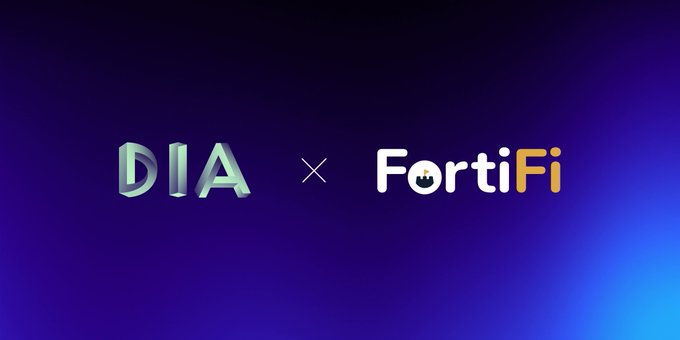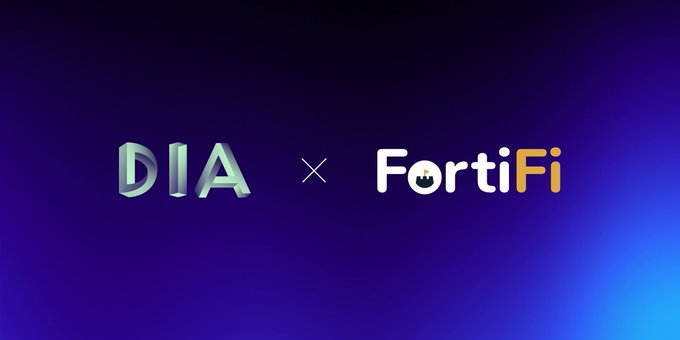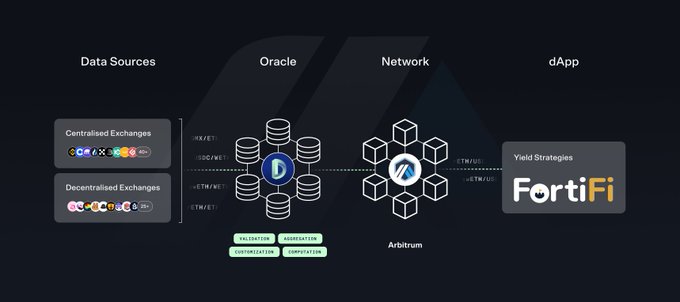Fortifi, a DeFi platform, has partnered with DIA to integrate custom oracles into their vault platform, supporting various assets such as $JOE, $GMX, $Grail, $swETH, rETH. The integration ensures precise price feeds across Arbitrum and Avalanche networks, enhancing strategy execution and providing users with secure, diversified investment options.
🔥 @DIAdata_org sealed a partnership with @FortiFi_ 🔥 #FortiFi is revolutionizing #DeFi with its advanced vault platform, providing users with one-click access to a variety of yield-bearing strategies 🔽 VISIT diadata.org/blog/post/part… #ARB_Universe
🎉 Partnership with FortiFi @FortiFi_ has partnered with DIA to integrate custom oracles into their advanced vault platform. This integration supports a wide range of assets and enhances strategy execution with precise, reliable price feeds across Arbitrum and Avalanche
DIA Oracles Expand with TAO, DASH, Adobe and ICP Price Feeds

**DIA oracles added four new price feeds this week:** - **$TAO** from Opentensor's decentralized ML network - **$DASH** from Dashpay's digital currency - **$ADBE** from Adobe as a Real World Asset (RWA) - **$ICP** from Dfinity's Internet Computer All feeds use **verifiable data from first-party sources** and are production-ready for DeFi integrations. This expansion builds on DIA's recent additions including $INTC, $HBAR, $LTC, and $XG, bringing their total supported feeds to over 10,000 assets across 60+ blockchain networks. Developers can now integrate these price feeds into their dApps for reliable, transparent pricing data.
ZircuitL2 Joins Infra Gardens V8 as Co-Host for Buenos Aires DevCon Event

**ZircuitL2 becomes new co-host** for Infra Gardens V8, bringing zk rollup expertise to the Buenos Aires event during EFDevcon. **Key highlights:** - Zircuit offers built-in sequencer-level security and MEV resistance - Event scheduled for November 20th, just 5 minutes from DevCon hub - Features panels on RWAs, privacy, and cross-chain tooling - Speakers include representatives from CoinDesk, Sei Network, Centrifuge, and Wormhole **Event format includes:** - High-signal networking opportunities - Technical panels and builder presentations - Relaxed venue atmosphere for meaningful connections This marks the 8th edition of the popular side event, previously held in Paris, Bangkok, and Cannes. [Sign up here](https://luma.com/InfraGardens-BuenosAires)
DIA Deploys Custom Oracle for Base Lending Markets
**DIA partners with Macro** to provide verifiable price feeds for three Base tokens: $TOSHI, $SKI, and $WMTx. **Key features:** - Multi-DEX aggregation with time-weighted averaging - Ensures fair collateral valuations - Enables proper liquidations across Base lending markets **Technical specs:** - VWAP methodology for accurate pricing - 0.1% deviation threshold for updates - 120-second refresh with 24h heartbeat This infrastructure supports Macro's decentralized lending protocol built on Morpho Labs, allowing users to borrow stablecoins against Base tokens or supply liquidity for yield. The partnership strengthens institutional-grade DeFi infrastructure on Base with transparent, real-time price data.
Adobe Stock Price Feed Now Available for DeFi Integration

**Adobe stock price feed launches for DeFi** DIA has released a new real-world asset (RWA) feed for Adobe ($ADBE/USD), making the creative software giant's stock price accessible to decentralized applications. **Key details:** - Adobe leads creative software with Photoshop, Illustrator, and Acrobat - Serves millions of creators and enterprises globally - Feed enables DeFi dApps to integrate Adobe stock data - Production-ready with verifiable onchain data This follows DIA's recent launch of Meta's stock feed, expanding their RWA offerings for traditional asset integration into DeFi protocols. [Access the Adobe feed](https://www.diadata.org/app/rwa/ADBE/)
AMAI Integrates DIA Oracles for Cross-Chain Price Verification Across 60+ Networks
**Cross-chain token launches face pricing challenges** across multiple networks, requiring accurate and transparent data. **AMAI partners with DIA oracles** to address price manipulation risks and ensure reliable data flows from source to execution. **Key benefits:** - Verifiable data across 60+ blockchain networks - Elimination of price manipulation vulnerabilities - Transparent pricing for multi-chain token deployments This integration represents a shift toward **first-party data verification** rather than simple price aggregation, providing complete audit trails from data source to smart contract execution. The partnership addresses growing demand for **reliable cross-chain infrastructure** as projects increasingly launch across multiple networks simultaneously.


